Grid Integration for Electric Vehicles: A Realistic Strategy for Environmentally Friendly Mobility and Renewable Power
Abstract
:1. Introduction
1.1. Motivation
1.2. Literature Review
1.3. Contribution
2. Hierarchical Structure of EV Charging Stations’ System Operation
- Output control involves the regulation of voltage and current in different converters. It is necessary to guarantee that these values closely follow the target values and that any oscillations are effectively suppressed.
- Power quality management refers to the capacity to uphold the necessary charging voltage and current for electric vehicle batteries, while minimising any adverse effects on the power system, such as limiting peak power and harmonic pollution.
- The capacity to maintain the operational balance, which includes maintaining a constant AC frequency and rectifier bus voltage, while also maintaining the ability to accommodate changes in load and generation is termed as power system stability.
- The capacity to meet the charging demand of consumers within a restricted time frame and to achieve the lowest possible costs without negatively impacting the happiness of users is what we mean when we talk about energy management and economic dispatch.
- One definition of ancillary service is the capacity to supply the local grid with either active or reactive power supporting.
2.1. Tertiary Control System
2.2. Secondary Control System
2.3. Primary Control System
2.4. Physical Layer of EV Charging Station
2.5. Intelligent EV Charging Algorithms
| Ref | Algorithm | Charging Type | Remarks |
|---|---|---|---|
| [75] | Multistage stochastic | Fast | Figure out the selection of charging stations for planning period. |
| [76] | Genetic Algorithm | Plug in | This study’s goals include locating charging stations in the best spot, lowering customers’ concerns about range anxiety, and minimising the costs of ownership. |
| [77] | Optimisation-based method that puts stations in the right place | Fast | This study adds a new constraint that is based on the process of building corridors and two new goal functions. |
| [78] | A computer-based model for finding the best place for a public charging station | Public charging | In this study, a simulation–optimisation model is used to figure out where chargers for electric cars should be placed so that private EVs can use them most efficiently. |
| [79] | Genetic Algorithm | Fast | Through the lens of price and demand elasticity, this study looks at the location issues that come up with fast-charging stations when there is input from network congestion. |
| [80] | Multistage stochastic | Fast | Figure out the selection of charging stations for planning period. |
3. Electric Vehicle Integration with the Utility Grid
3.1. Modalities of the Electricity Interface between Electric Vehicles and the Grid
3.2. The Importance of Using Sustainable Energy
3.3. Integrating EVs and Their Impacts on the Grid
3.4. Role of Agent in the EVGI
3.5. EV Aggregators’ Function within the EVGI
4. Conclusions
Author Contributions
Funding
Conflicts of Interest
References
- Li, P.; Zhang, Z.; Grosu, R.; Deng, Z.; Hou, J.; Rong, Y.; Wu, R. An end-to-end neural network framework for state-of-health estimation and remaining useful life prediction of electric vehicle lithium batteries. Renew. Sustain. Energy Rev. 2021, 156, 111843. [Google Scholar] [CrossRef]
- Ahrabi, M.; Abedi, M.; Nafisi, H.; Mirzaei, M.A.; Mohammadi-Ivatloo, B.; Marzband, M. Evaluating the effect of electric vehicle parking lots in transmission-constrained AC unit commitment under a hybrid IGDT-stochastic approach. Int. J. Electr. Power Energy Syst. 2021, 125, 106546. [Google Scholar] [CrossRef]
- Alabi, T.M.; Lu, L.; Yang, Z. Improved hybrid inexact optimal scheduling of virtual powerplant (VPP) for zero-carbon multi-energy system (ZCMES) incorporating Electric Vehicle (EV) multi-flexible approach. J. Clean. Prod. 2021, 326, 129294. [Google Scholar] [CrossRef]
- Al-Gabalawy, M. Reinforcement learning for the optimization of electric vehicle virtual power plants. Int. Trans. Electr. Energy Syst. 2021, 31, e12951. [Google Scholar] [CrossRef]
- Michiorri, A.; Nguyen, H.M.; Alessandrini, S.; Bremnes, J.B.; Dierer, S.; Ferrero, E.; Nygaard, B.E.; Pinson, P.; Thomaidis, N.; Uski, S. Forecasting for dynamic line rating. Renew Sustain. Energy Rev. 2015, 52, 1713–1730. [Google Scholar] [CrossRef]
- Stawska, A.; Romero, N.; de Weerdt, M.; Verzijlbergh, R. Demand response: For congestion management or for grid balancing? Energy Policy 2020, 148, 111920. [Google Scholar] [CrossRef]
- Naval, N.; Yusta, J.M. Virtual power plant models and electricity markets—A review. Renew. Sustain. Energy Rev. 2021, 149, 111393. [Google Scholar] [CrossRef]
- Heydari-Doostabad, H.; O’Donnell, T. A Wide-Range High-Voltage-Gain Bidirectional DC–DC Converter for V2G and G2V Hybrid EV Charger. IEEE Trans. Ind. Electron. 2021, 69, 4718–4729. [Google Scholar] [CrossRef]
- He, T.; Lu, D.D.-C.; Wu, M.; Yang, Q.; Li, T.; Liu, Q. Four-Quadrant Operations of Bidirectional Chargers for Electric Vehicles in Smart Car Parks: G2V, V2G, and V4G. Energies 2020, 14, 181. [Google Scholar] [CrossRef]
- Li, X.; Tan, Y.; Liu, X.; Liao, Q.; Sun, B.; Cao, G.; Li, C.; Yang, X.; Wang, Z. A cost-benefit analysis of V2G electric vehicles supporting peak shaving in Shanghai. Electr. Power Syst. Res. 2019, 179, 106058. [Google Scholar] [CrossRef]
- Logavani, K.; Ambikapathy, A.; Arun Prasad, G.; Faraz, A.; Singh, H. Smart Grid, V2G and Renewable Integration. In Green Energy and Technology; Springer: Singapore, 2021. [Google Scholar]
- Wang, K.; Chen, S.; Liu, L.; Zhu, T.; Gan, Z. Enhancement of renewable energy penetration through energy storage technologies in a CHP-based energy system for Chongming, China. Energy 2018, 162, 988–1002. [Google Scholar] [CrossRef]
- Sufyan, M.; Rahim, N.; Muhammad, M.; Tan, C.; Raihan, S.; Bakar, A. Charge coordination and battery lifecycle analysis of electric vehicles with V2G implementation. Electr. Power Syst. Res. 2020, 184, 106307. [Google Scholar] [CrossRef]
- Alsharif, A.; Tan, C.W.; Ayop, R.; Dobi, A.; Lau, K.Y. A comprehensive review of energy management strategy in Vehicle-to-Grid technology integrated with renewable energy sources. Sustain. Energy Technol. Assess. 2021, 47, 101439. [Google Scholar] [CrossRef]
- Hussain, M.T.; Sulaiman, N.B.; Hussain, M.S.; Jabir, M. Optimal Management strategies to solve issues of grid having Electric Vehicles (EV): A review. J. Energy Storage 2021, 33, 102114. [Google Scholar] [CrossRef]
- Khalid, M.R.; Alam, M.S.; Sarwar, A.; Jamil Asghar, M.S. A Comprehensive review on electric vehicles charging infrastruc-tures and their impacts on power-quality of the utility grid. eTransportation 2019, 1, 100006. [Google Scholar] [CrossRef]
- Das, H.S.; Rahman, M.M.; Li, S.; Tan, C.W. Electric vehicles standards, charging infrastructure, and impact on grid integra-tion: A technological review. Renew. Sustain. Energy Rev. 2020, 120, 109618. [Google Scholar] [CrossRef]
- Goel, S.; Sharma, R.; Rathore, A.K. A review on barrier and challenges of electric vehicle in India and vehicle to grid opti-misation. Transp. Eng. 2021, 4, 100057. [Google Scholar] [CrossRef]
- Habib, S.; Kamran, M.; Rashid, U. Impact analysis of vehicle-to-grid technology and charging strategies of electric vehicles on distribution networks—A review. J. Power Sources 2015, 277, 205–214. [Google Scholar] [CrossRef]
- Yilmaz, M.; Krein, P.T. Review of benefits and challenges of vehicle-to-grid technology. In Proceedings of the 2012 IEEE Energy Conversion Congress and Exposition, Raleigh, NC, USA, 15–20 September 2012. [Google Scholar]
- Yilmaz, M.; Krein, P.T. Review of the impact of vehicle-to-grid technologies on distribution systems and utility interfaces. IEEE Trans. Power Electron. 2013, 28, 5673–5689. [Google Scholar] [CrossRef]
- Sovacool, B.K.; Kester, J.; Noel, L.; Zarazua de Rubens, G. Actors, business models, and innovation activity systems for ve-hicle-to-grid (V2G) technology: A comprehensive review. Renew. Sustain. Energy Rev. 2020, 131, 109963. [Google Scholar] [CrossRef]
- Heilmann, C.; Friedl, G. Factors influencing the economic success of grid-to-vehicle and vehicle-to-grid applications—A review and meta-analysis. Renew. Sustain. Energy Rev. 2021, 145, 111115. [Google Scholar] [CrossRef]
- Shaukat, N.; Khan, B.; Ali, S.M.; Mehmood, C.A.; Khan, J.; Farid, U.; Majid, M.; Anwar, S.M.; Jawad, M.; Ullah, Z. A survey on electric vehicle transportation within smart grid system. Renew. Sustain. Energy Rev. 2018, 81, 1329–1349. [Google Scholar] [CrossRef]
- Vadi, S.; Bayindir, R.; Colak, A.M.; Hossain, E. A review on communication standards and charging topologies of V2G and V2H operation strategies. Energies 2019, 12, 3748. [Google Scholar] [CrossRef]
- Monteiro, V.; Pinto, J.G.; Afonso, J.L. Operation Modes for the Electric Vehicle in Smart Grids and Smart Homes: Present and Proposed Modes. IEEE Trans. Veh. Technol. 2015, 65, 1007–1020. [Google Scholar] [CrossRef]
- Zheng, Y.; Niu, S.; Shang, Y.; Shao, Z.; Jian, L. Integrating plug-in electric vehicles into power grids: A comprehensive review on pow-er interaction mode, scheduling methodology and mathematical foundation. Renew. Sustain. Energy Rev. 2019, 112, 424–439. [Google Scholar] [CrossRef]
- Liu, C.; Chau, K.T.; Wu, D.; Gao, S. Opportunities and Challenges of Vehicle-to-Home, Vehicle-to-Vehicle, and Vehicle-to-Grid Technologies. Proc. IEEE 2013, 101, 2409–2427. [Google Scholar] [CrossRef]
- Sharma, A.; Sharma, S. Review of power electronics in vehicle-to-grid systems. J. Energy Storage 2019, 21, 337–361. [Google Scholar] [CrossRef]
- Tan, K.M.; Ramachandaramurthy, V.K.; Yong, J.Y. Integration of electric vehicles in smart grid: A review on vehicle to grid technologies and optimization techniques. Renew. Sustain. Energy Rev. 2016, 53, 720–732. [Google Scholar] [CrossRef]
- Sovacool, B.K.; Noel, L.; Axsen, J.; Kempton, W. The neglected social dimensions to a vehicle-to-grid (V2G) transition: A critical and systematic review. Environ. Res. Lett. 2018, 13, 13001. [Google Scholar] [CrossRef]
- Richardson, D.B. Electric vehicles and the electric grid: A review of modeling approaches, Impacts, and renewable energy integration. Renew. Sustain. Energy Rev. 2013, 19, 247–254. [Google Scholar] [CrossRef]
- Ravi, S.S.; Aziz, M. Utilization of Electric Vehicles for Vehicle-to-Grid Services: Progress and Perspectives. Energies 2022, 15, 589. [Google Scholar] [CrossRef]
- Sovacool, B.K.; Axsen, J.; Kempton, W. The Future Promise of Vehicle-to-Grid (V2G) Integration: A Sociotechnical Review and Research Agenda. Annu. Rev. Environ. Resour. 2017, 42, 377–406. [Google Scholar] [CrossRef]
- Mastoi, M.S.; Zhuang, S.; Munir, H.M.; Haris, M.; Hassan, M.; Usman, M.; Bukhari, S.S.; Ro, J.S. An in-depth analysis of electric vehicle charging station infrastructure, policy implications, and future trends. Energy Rep. 2022, 8, 11504–11529. [Google Scholar] [CrossRef]
- Yong, J.Y.; Tan, W.S.; Khorasany, M.; Razzaghi, R. Electric vehicles destination charging: An overview of charging tariffs, business models and coordination strategies. Renew. Sustain. Energy Rev. 2023, 184, 113534. [Google Scholar] [CrossRef]
- Alanazi, F. Electric Vehicles: Benefits, Challenges, and Potential Solutions for Widespread Adaptation. Appl. Sci. 2023, 13, 6016. [Google Scholar] [CrossRef]
- Barman, P.; Dutta, L.; Bordoloi, S.; Kalita, A.; Buragohain, P.; Bharali, S.; Azzopardi, B. Renewable energy integration with electric vehicle technology: A review of the existing smart charging approaches. Renew. Sustain. Energy Rev. 2023, 183, 113518. [Google Scholar] [CrossRef]
- Arif, S.M.; Lie, T.T.; Seet, B.C.; Ayyadi, S.; Jensen, K. Review of Electric Vehicle Technologies, Charging Methods, Standards and Optimization Techniques. Electronics 2021, 10, 1910. [Google Scholar] [CrossRef]
- Liu, Z.; Wu, Q.; Huang, S.; Wang, L.; Shahidehpour, M.; Xue, Y. Optimal Day-Ahead Charging Scheduling of Electric Vehicles Through an Aggregative Game Model. IEEE Trans. Smart Grid 2017, 9, 5173–5184. [Google Scholar] [CrossRef]
- Mao, T.; Lau, W.-H.; Shum, C.; Chung, H.S.-H.; Tsang, K.-F.; Tse, N.C.-F. A Regulation Policy of EV Discharging Price for Demand Scheduling. IEEE Trans. Power Syst. 2017, 33, 1275–1288. [Google Scholar] [CrossRef]
- Ghosh, A.; Aggarwal, V. Control of charging of electric vehicles through menu-based pricing under uncertainty. In Proceedings of the IEEE International Conference on Communications 2017, Paris, France, 21–25 May 2017. [Google Scholar]
- Dong, X.; Mu, Y.; Xu, X.; Jia, H.; Wu, J.; Yu, X.; Qi, Y. A charging pricing strategy of electric vehicle fast charging stations for the voltage control of electricity distribution networks. Appl. Energy 2018, 225, 857–868. [Google Scholar] [CrossRef]
- Tushar, M.H.K.; Zeineddine, A.W.; Assi, C.M. Demand-Side Management by Regulating Charging and Discharging of the EV, ESS, and Utilizing Renewable Energy. IEEE Trans. Ind. Inform. 2018, 14, 117–126. [Google Scholar] [CrossRef]
- Yan, Q.; Zhang, B.; Kezunovic, M. Optimized Operational Cost Reduction for an EV Charging Station Integrated With Battery Energy Storage and PV Generation. IEEE Trans. Smart Grid 2018, 10, 2096–2106. [Google Scholar] [CrossRef]
- Gupta, A.; Doolla, S.; Chatterjee, K. Hybrid AC–DC Microgrid: Systematic Evaluation of Control Strategies. IEEE Trans. Smart Grid 2017, 9, 3830–3843. [Google Scholar] [CrossRef]
- Sahoo, S.K.; Sinha, A.K.; Kishore, N.K. Control Techniques in AC, DC, and Hybrid AC-DC Microgrid: A Review. IEEE J. Emerg. Sel. Top. Power Electron. 2018, 6, 738–759. [Google Scholar] [CrossRef]
- Shahnia, F.; Majumder, R.; Ghosh, A.; Ledwich, G.; Zare, F. Operation and control of a hybrid microgrid containing unbalanced and nonlinear loads. Electr. Power Syst. Res. 2010, 80, 954–965. [Google Scholar] [CrossRef]
- Guo, W.; Han, X.; Ren, C.; Wang, P. Control method of bidirectional AC/DC converter with unbalanced voltage in hybrid micro-grid. Dianwang Jishu Power Syst. Technol. 2016, 40, 381–386. [Google Scholar] [CrossRef]
- Dragicevic, T.; Lu, X.; Vasquez, J.C.; Guerrero, J.M. DC Microgrids—Part I: A Review of Control Strategies and Stabilization Techniques. IEEE Trans. Power Electron. 2016, 31, 4876–4891. [Google Scholar] [CrossRef]
- Mwasilu, F.; Justo, J.J.; Kim, E.K.; Do, T.D.; Jung, J.W. Electric vehicles and smart grid interaction: A review on vehicle to grid and renewa-ble energy sources integration. Renew. Sustain. Energy Rev. 2014, 34, 501–516. [Google Scholar] [CrossRef]
- IEC 61851-1:2019; Electric Vehicle Conductive Charging System—Part 1: General Requirements. IEC: Geneva, Switzerland, 2019. Available online: https://www.intertekinform.com/preview/497265146615.pdf?sku=1158209_SAIG_NSAI_NSAI_2751390 (accessed on 22 August 2023).
- SAE International. SAE J3016: Levels of Driving Automation. Soc. Automot. Eng. 2021, 5, 1689–1699. [Google Scholar]
- Derïcïoğlu; Yïrïk, E.; Ünal, E.; Cuma, M.U.; Onur, B.; Tümay, M. A review of charging technologies for commercial electric vehicles. Int. J. Adv. Automot. Technol. 2018, 2, 61–70. [Google Scholar] [CrossRef]
- Elma, O.; Cali, U.; Kuzlu, M. An overview of bidirectional electric vehicles charging system as a Vehicle to Anything (V2X) under Cyber–Physical Power System (CPPS). Energy Rep. 2022, 8, 25–32. [Google Scholar] [CrossRef]
- Priyasta, D.; Hadiyanto; Septiawan, R. Enabling EV Roaming Through Cascading WebSockets in OCPP 1.6. J. Eur. Des Syst. Autom. 2023, 56, 437–449. [Google Scholar] [CrossRef]
- Sharma, S.; Panwar, A.K.; Tripathi, M.M. Storage technologies for electric vehicles. J. Traffic Transp. Eng. Engl. Ed. 2020, 7, 340–361. [Google Scholar] [CrossRef]
- Mohan, H.M.; Dash, S.K. Renewable Energy-Based DC Microgrid with Hybrid Energy Management System Supporting Electric Vehicle Charging System. Systems 2023, 11, 273. [Google Scholar] [CrossRef]
- Verma, S.; Mishra, S.; Gaur, A.; Chowdhury, S.; Mohapatra, S.; Dwivedi, G.; Verma, P. A comprehensive review on energy storage in hybrid electric vehicle. J. Traffic Transp. Eng. Engl. Ed. 2021, 8, 621–637. [Google Scholar] [CrossRef]
- Kwon, M.; Choi, S. An Electrolytic Capacitorless Bidirectional EV Charger for V2G and V2H Applications. IEEE Trans. Power Electron. 2016, 32, 6792–6799. [Google Scholar] [CrossRef]
- Lee, B.-K.; Kim, J.-P.; Kim, S.-G.; Lee, J.-Y. An Isolated/Bidirectional PWM Resonant Converter for V2G(H) EV On-Board Charger. IEEE Trans. Veh. Technol. 2017, 66, 7741–7750. [Google Scholar] [CrossRef]
- Lim, K.L.; Speidel, S.; Bräunl, T. A comparative study of AC and DC public electric vehicle charging station usage in Western Australia. Renew. Sustain. Energy Transit. 2022, 2, 100021. [Google Scholar] [CrossRef]
- Tu, H.; Feng, H.; Srdic, S.; Lukic, S. Extreme Fast Charging of Electric Vehicles: A Technology Overview. IEEE Trans. Transp. Electrif. 2019, 5, 861–878. [Google Scholar] [CrossRef]
- Chang, K.-H. Multiobjective Optimization and Advanced Topics. In e-Design; Elsevier: Amsterdam, The Netherlands, 2015; pp. 1105–1173. [Google Scholar]
- Taghizad-Tavana, K.; Alizadeh, A.; Ghanbari-Ghalehjoughi, M.; Nojavan, S. A Comprehensive Review of Electric Vehicles in Energy Systems: Integration with Renewable Energy Sources, Charging Levels, Different Types, and Standards. Energies 2023, 16, 630. [Google Scholar] [CrossRef]
- Hassanat, A.; Almohammadi, K.; Alkafaween, E.; Abunawas, E.; Hammouri, A.; Prasath, V.B.S. Choosing Mutation and Crossover Ratios for Genetic Algorithms—A Review with a New Dynamic Approach. Information 2019, 10, 390. [Google Scholar] [CrossRef]
- Orosz, T.; Rassõlkin, A.; Kallaste, A.; Arsénio, P.; Pánek, D.; Kaska, J.; Karban, P. Robust Design Optimization and Emerging Technologies for Electrical Machines: Challenges and Open Problems. Appl. Sci. 2020, 10, 6653. [Google Scholar] [CrossRef]
- Surucu, O.; Gadsden, S.A.; Yawney, J. Condition Monitoring using Machine Learning: A Review of Theory, Applications, and Recent Advances. Expert Syst. Appl. 2023, 221, 119738. [Google Scholar] [CrossRef]
- Ryan, C. Evolutionary Algorithms and Metaheuristics. In: Encyclopedia of Physical Science and Technology. Elsevier 2003, 162, 673–685. [Google Scholar]
- Yang, X.-S.; He, X.-S.; Fan, Q.-W. Mathematical framework for algorithm analysis. In Nature-Inspired Computation and Swarm Intelligence; Elsevier: Amsterdam, The Netherlands, 2020; pp. 89–108. [Google Scholar]
- Zhou, G.; Zhu, Z.; Luo, S. Location optimization of electric vehicle charging stations: Based on cost model and genetic algorithm. Energy 2022, 247, 123437. [Google Scholar] [CrossRef]
- Sarker, I.H. Machine Learning: Algorithms, Real-World Applications and Research Directions. SN Comput. Sci. 2021, 2, 160. [Google Scholar] [CrossRef]
- Wang, J.-S.; Song, J.-D. Function Optimization and Parameter Performance Analysis Based on Gravitation Search Algorithm. Algorithms 2015, 9, 3. [Google Scholar] [CrossRef]
- Haq, Z.U.; Ullah, H.; Khan, M.N.A.; Naqvi, S.R.; Ahad, A.; Amin, N.A.S. Comparative study of machine learning methods integrated with genetic algorithm and particle swarm optimization for bio-char yield prediction. Bioresour. Technol. 2022, 363, 128008. [Google Scholar] [CrossRef]
- Kadri, A.A.; Perrouault, R.; Boujelben, M.K.; Gicquel, C. A multi-stage stochastic integer programming approach for locating electric vehicle charging stations. Comput. Oper. Res. 2020, 117, 104888. [Google Scholar] [CrossRef]
- Zhu, Z.-H.; Gao, Z.-Y.; Zheng, J.-F.; Du, H.-M. Charging station location problem of plug-in electric vehicles. J. Transp. Geogr. 2016, 52, 11–22. [Google Scholar] [CrossRef]
- Erdoğan, S.; Çapar, I.; Nejad, M.M. Establishing a statewide electric vehicle charging station network in Maryland: A corridor-based station location problem. Socio-Econ. Plan. Sci. 2021, 79, 101127. [Google Scholar] [CrossRef]
- Huang, Y.; Wu, X.; Jing, J. Research on the electric vehicle heat pump air conditioning system based on R290 refrigerant. Energy Rep. 2022, 8, 447–455. [Google Scholar] [CrossRef]
- Huang, K.; Kanaroglou, P.; Zhang, X. The design of electric vehicle charging network. Transp. Res. Part D Transp. Environ. 2016, 49, 1–17. [Google Scholar] [CrossRef]
- Shetty, D.K.; Shetty, S.; Rodrigues, L.R.; Naik, N.; Maddodi, C.B.; Malarout, N.; Sooriyaperakasam, N. Barriers to widespread adoption of plug-in electric vehicles in emerging Asian markets: An analysis of consumer behavioral attitudes and perceptions. Cogent Eng. 2020, 7, 1. [Google Scholar] [CrossRef]
- Powell, S.; Cezar, G.V.; Min, L.; Azevedo, I.M.L.; Rajagopal, R. Charging infrastructure access and operation to reduce the grid impacts of deep electric vehicle adoption. Nat. Energy 2022, 7, 932–945. [Google Scholar] [CrossRef]
- Shabalov, M.; Zhukovskiy, Y.; Buldysko, A.; Gil, B.; Starshaia, V. The influence of technological changes in energy efficiency on the infrastructure deterioration in the energy sector. Energy Rep. 2021, 7, 2664–2680. [Google Scholar] [CrossRef]
- Aghajan-Eshkevari, S.; Azad, S.; Nazari-Heris, M.; Ameli, M.T.; Asadi, S. Charging and Discharging of Electric Vehicles in Power Systems: An Updated and Detailed Review of Methods, Control Structures, Objectives, and Optimization Methodologies. Sustainability 2022, 14, 2137. [Google Scholar] [CrossRef]
- Nour, M.; Chaves-Ávila, J.P.; Magdy, G.; Sánchez-Miralles, Á. Review of positive and negative impacts of electric vehicles charging on electric power systems. Energies 2020, 13, 4675. [Google Scholar] [CrossRef]
- Bryła, P.; Chatterjee, S.; Ciabiada-Bryła, B. Consumer Adoption of Electric Vehicles: A Systematic Literature Review. Energies 2023, 16, 205. [Google Scholar] [CrossRef]
- Mojumder, R.H.; Antara, F.A.; Hasanuzzaman; Alamri, B.; Alsharef, M. Electric Vehicle-to-Grid (V2G) Technologies: Impact on the Power Grid and Battery. Sustainability 2022, 14, 13856. [Google Scholar] [CrossRef]
- IEA (International Energy Agency). The Future of Hydrogen: Seizing Today’s Opportunities. 2019. Available online: https://mlienvironmental.com/blog/effects-of-hazardous-waste/ (accessed on 22 August 2023).
- Dey, S.; Sreenivasulu, A.; Veerendra, G.; Rao, K.V.; Babu, P.A. Renewable energy present status and future potentials in India: An overview. Innov. Green Dev. 2022, 1, 100006. [Google Scholar] [CrossRef]
- What Are the Problems Faced by Renewable Energy? Available online: https://regenpower.com/what-are-the-problems-faced-by-renewable-energy/ (accessed on 30 August 2023).
- Hassan, Q.; Algburi, S.; Sameen, A.Z.; Salman, H.M.; Jaszczur, M. A review of hybrid renewable energy systems: Solar and wind-powered solutions: Challenges, opportunities, and policy implications. Results Eng. 2023, 20, 10162. [Google Scholar] [CrossRef]
- Cao, J.; Chen, X.; Qiu, R.; Hou, S. Electric vehicle industry sustainable development with a stakeholder engagement system. Technol. Soc. 2021, 67, 101771. [Google Scholar] [CrossRef]
- Srivastava, A.; Manas, M.; Dubey, R.K. Electric vehicle integration’s impacts on power quality in distribution network and associated mitigation measures: A review. J. Eng. Appl. Sci. 2023, 70, 32. [Google Scholar] [CrossRef]
- Saldarriaga-Zuluaga, S.D.; López-Lezama, J.M.; Ríos, C.D.Z.; Jaramillo, A.V. Effects of the Incorporation of Electric Vehicles on Protection Coordination in Microgrids. World Electr. Veh. J. 2022, 13, 163. [Google Scholar] [CrossRef]
- Shazon, M.N.H.; Nahid-Al-Masood Jawad, A. Frequency control challenges and potential countermeasures in future low-inertia power systems: A review. Energy Rep. 2022, 8, 6191–6219. [Google Scholar] [CrossRef]
- Mengelkamp, E.; Gärttner, J.; Rock, K.; Kessler, S.; Orsini, L.; Weinhardt, C. Designing microgrid energy markets: A case study: The Brooklyn Microgrid. Appl. Energy 2018, 210, 870–880. [Google Scholar] [CrossRef]
- Strepparava, D.; Nespoli, L.; Kapassa, E.; Touloupou, M.; Katelaris, L.; Medici, V. Deployment and analysis of a blockchain-based local energy market. Energy Rep. 2021, 8, 99–113. [Google Scholar] [CrossRef]
- Afsharian, M.; Ahn, H.; Kamali, S. Performance analytics in incentive regulation: A literature review of DEA publications. Decis. Anal. J. 2022, 4, 00079. [Google Scholar] [CrossRef]
- VIRTA. Vehicle-to-Grid (v2g): Everything You Need to Know. 2023. Available online: https://www.virta.global/vehicle-to-grid-v2g#:~:text=With%20V2G%20technology%2C%20an%20EV,back%20to%20the%20power%20grid (accessed on 3 September 2023).
- Mastoi, M.S.; Zhuang, S.; Munir, H.M.; Haris, M.; Hassan, M.; Alqarni, M.; Alamri, B. A study of charging-dispatch strategies and vehicle-to-grid technologies for electric vehicles in distribution networks. Energy Rep. 2023, 9, 1777–1806. [Google Scholar] [CrossRef]
- Nazari-Heris, M.; Abapour, M.; Mohammadi-Ivatloo, B. An Updated Review and Outlook on Electric Vehicle Aggregators in Electric Energy Networks. Sustainability 2022, 14, 15747. [Google Scholar] [CrossRef]
- Iwafune, Y.; Kazuhiko, O.; Kobayashi, Y.; Suzuki, K.; Shimoda, Y. Aggregation model of various demand-side energy resources in the day-ahead electricity market and imbalance pricing system. Int. J. Electr. Power Energy Syst. 2023, 147, 108875. [Google Scholar] [CrossRef]
- Vanting, N.B.; Ma, Z.; Jørgensen, B.N. Evaluation of neural networks for residential load forecasting and the impact of systematic feature identification. Energy Inform. 2022, 5, 63. [Google Scholar] [CrossRef]
- Cao, Y.; Huang, L.; Li, Y.; Jermsittiparsert, K.; Ahmadi-Nezamabad, H.; Nojavan, S. Optimal scheduling of electric vehicles aggregator under market price uncertainty using robust optimization technique. Int. J. Electr. Power Energy Syst. 2020, 117, 105628. [Google Scholar] [CrossRef]
- Liu, D.; Wang, W.; Wang, L.; Jia, H.; Shi, M. Dynamic Pricing Strategy of Electric Vehicle Aggregators Based on DDPG Reinforcement Learning Algorithm. IEEE Access 2021, 9, 21556–21566. [Google Scholar] [CrossRef]
- Feng, X.; Hu, F.; Cao, H.; Tang, L. A robust optimization model for multiple electricity retailers based on electricity trading in the presence of demand response program. Int. J. Electr. Power Energy Syst. 2023, 153, 109362. [Google Scholar] [CrossRef]
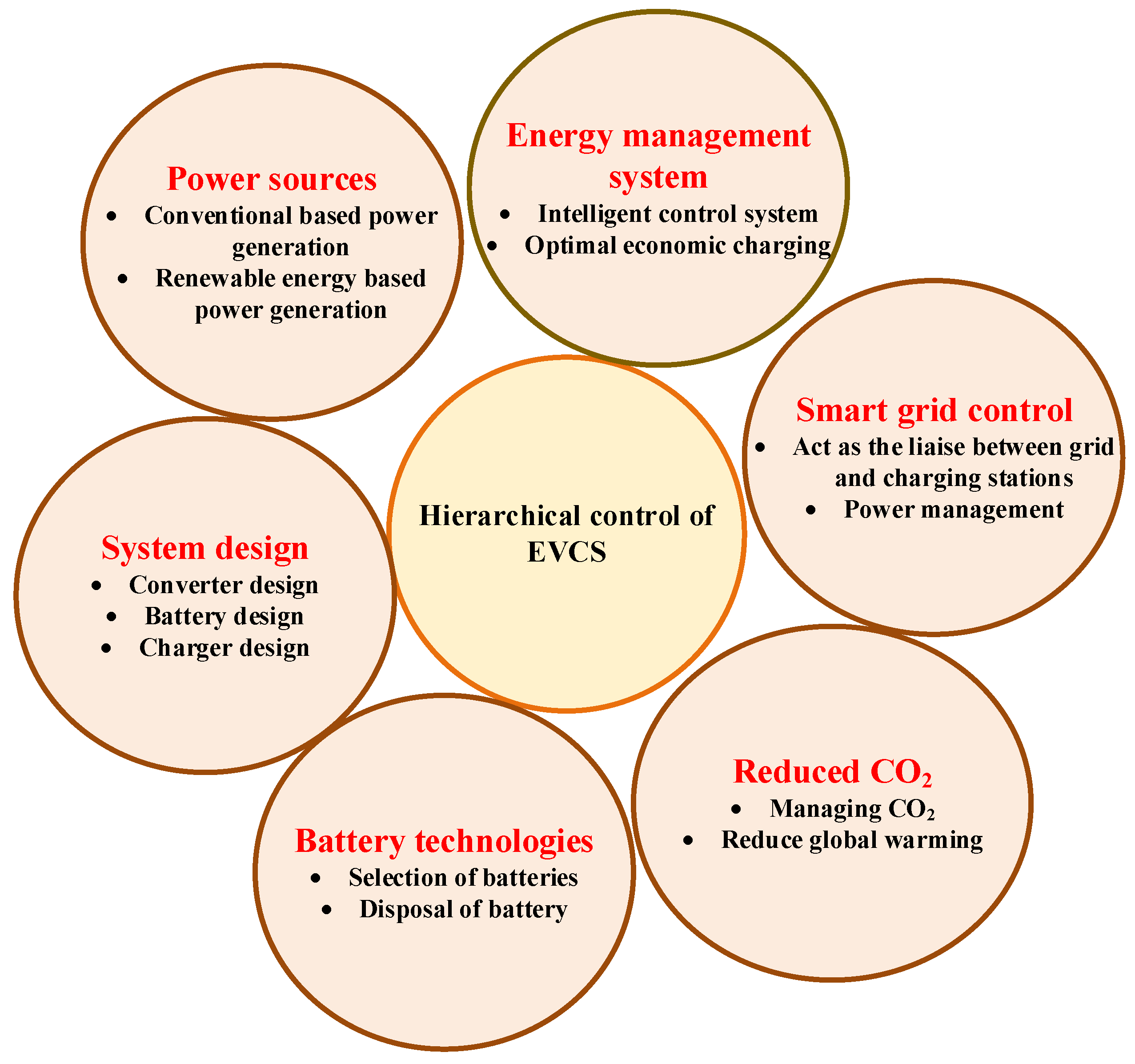

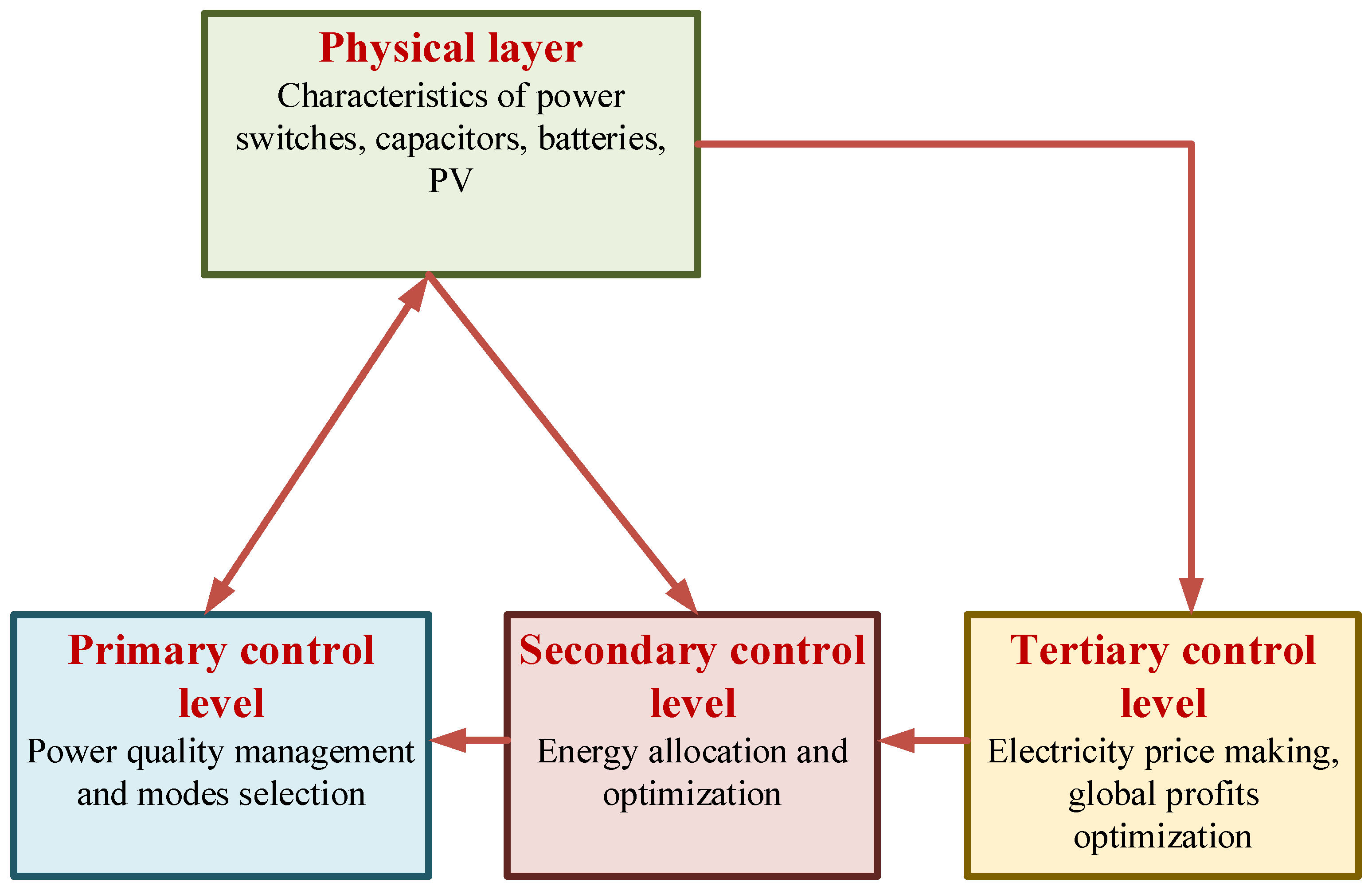
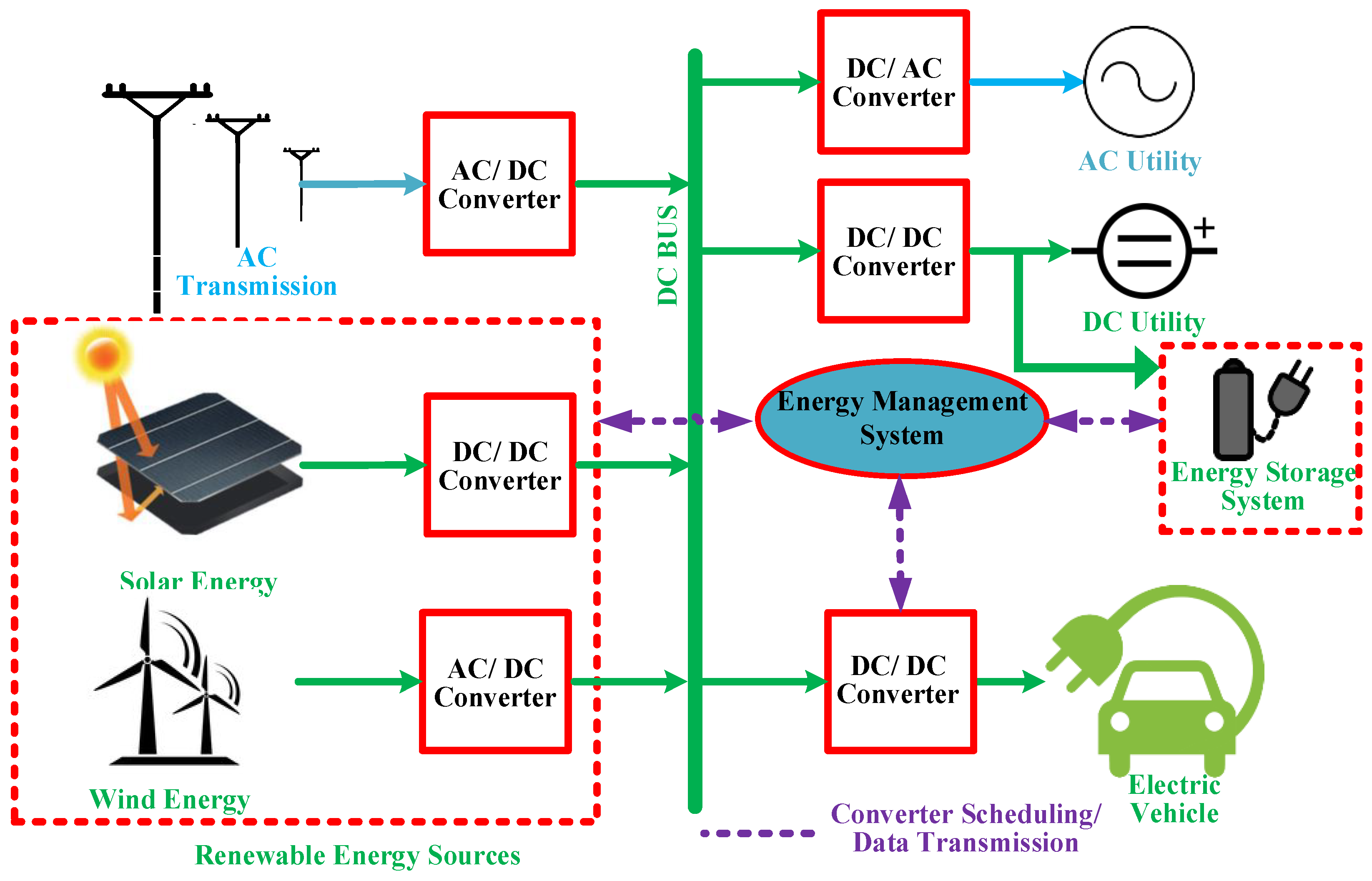
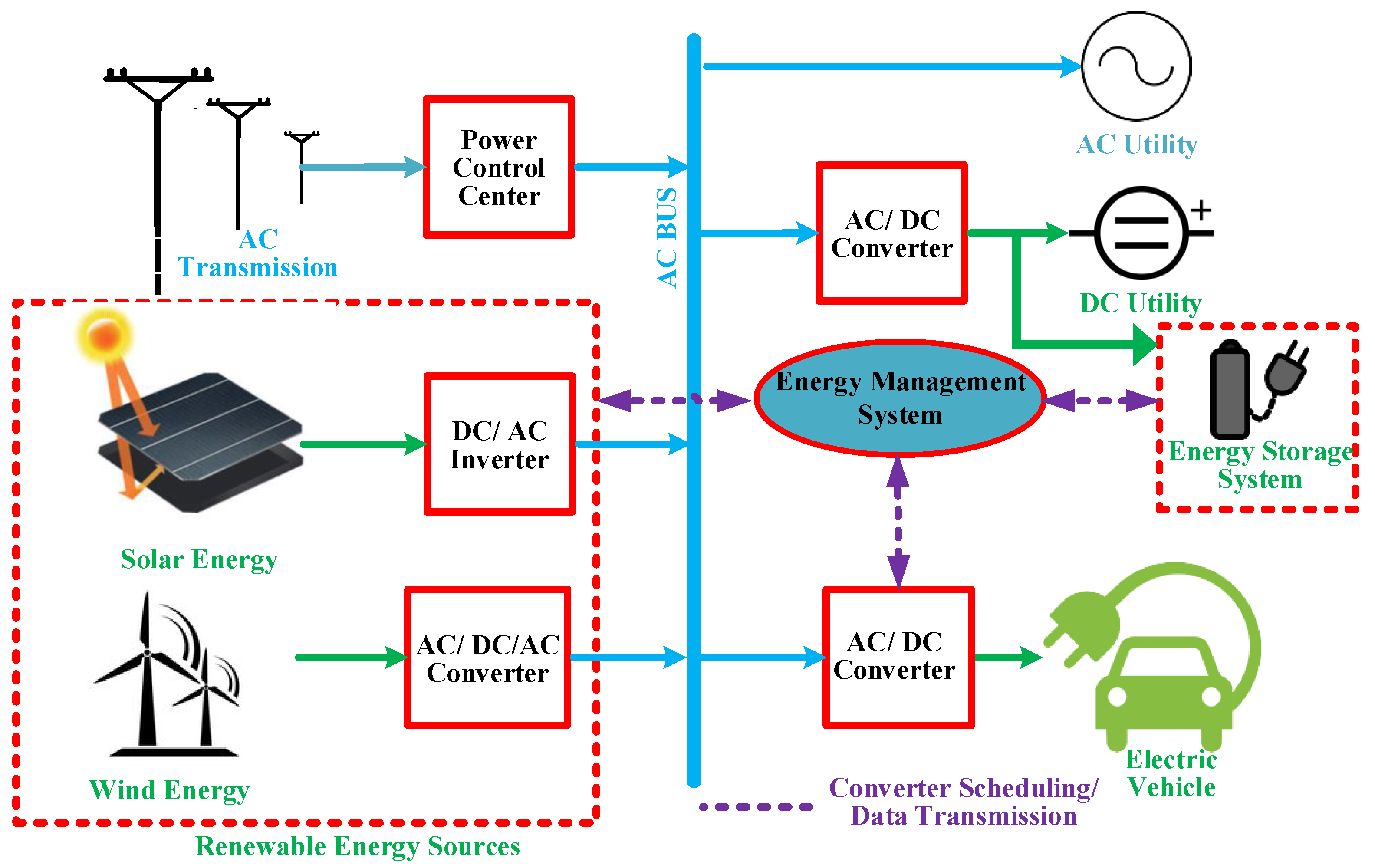
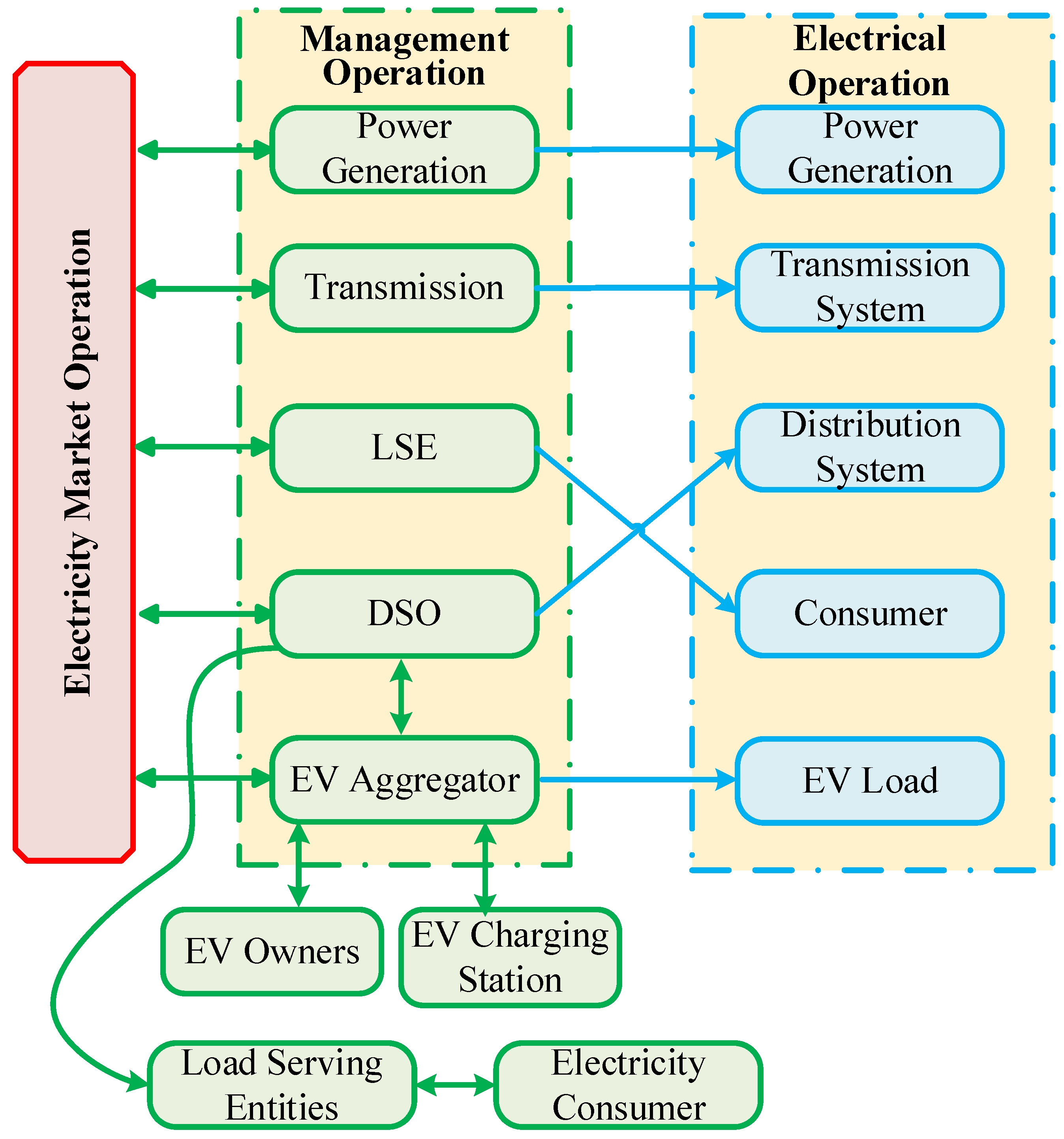

| Modes of Operation | Power Flow | Charging/Discharging |
|---|---|---|
| Uncontrolled charging | G2V | Regular, unintelligent, and unregulated |
| Unidirectional charging | G2V | Intelligent, coordinate, and controlled |
| Bidirectional | V2G and G2V | Intelligent, coordinate, and controlled |
| Effect | Remarks |
|---|---|
| Impact on power quality |
|
| Impact on voltage stability |
|
| Impact on grid stability |
|
| Supply and demand balance |
|
| Impact on load |
|
| Agent Titles | Remarks |
|---|---|
| Charging point managers | Charging point administrators oversee the operation of EV charging and discharging stations and serve as the ultimate consumers. |
| EV suppliers–aggregators | Supplies power to individuals who own electric automobiles. |
| Collector | Like other wholesale agents, they function in a similar manner. |
| EV owner | The EV load demand dictates the auxiliary services that can be offered by EVs over V2G, while the EV itself supplies the electricity for battery recharging. |
| Distribution | Ensures the durability and safety of the distribution network by managing the distribution grid. Ensures the overall stability and optimisation of the entire system, establishes a distribution network that is equitable and economically sustainable, and promotes a competitive energy market. |
| Transmission | Oversees the security of the gearbox system’s operations and the acquisition of system services, particularly operational maintenance. |
| Load serving entity | The responsibility of selling energy to end customers lies with the suppliers or Retailer Agent, whereas the responsibility of paying distribution system operator (DSO) costs related to deregulated and other service fees lies with the DSO. |
| Power Generation | Ensures the generation and sale of energy at a profitable rate by submitting bids for electricity pricing in the electricity market. |
Disclaimer/Publisher’s Note: The statements, opinions and data contained in all publications are solely those of the individual author(s) and contributor(s) and not of MDPI and/or the editor(s). MDPI and/or the editor(s) disclaim responsibility for any injury to people or property resulting from any ideas, methods, instructions or products referred to in the content. |
© 2024 by the authors. Licensee MDPI, Basel, Switzerland. This article is an open access article distributed under the terms and conditions of the Creative Commons Attribution (CC BY) license (https://creativecommons.org/licenses/by/4.0/).
Share and Cite
Vishnuram, P.; Alagarsamy, S. Grid Integration for Electric Vehicles: A Realistic Strategy for Environmentally Friendly Mobility and Renewable Power. World Electr. Veh. J. 2024, 15, 70. https://doi.org/10.3390/wevj15020070
Vishnuram P, Alagarsamy S. Grid Integration for Electric Vehicles: A Realistic Strategy for Environmentally Friendly Mobility and Renewable Power. World Electric Vehicle Journal. 2024; 15(2):70. https://doi.org/10.3390/wevj15020070
Chicago/Turabian StyleVishnuram, Pradeep, and Sureshkumar Alagarsamy. 2024. "Grid Integration for Electric Vehicles: A Realistic Strategy for Environmentally Friendly Mobility and Renewable Power" World Electric Vehicle Journal 15, no. 2: 70. https://doi.org/10.3390/wevj15020070
APA StyleVishnuram, P., & Alagarsamy, S. (2024). Grid Integration for Electric Vehicles: A Realistic Strategy for Environmentally Friendly Mobility and Renewable Power. World Electric Vehicle Journal, 15(2), 70. https://doi.org/10.3390/wevj15020070







